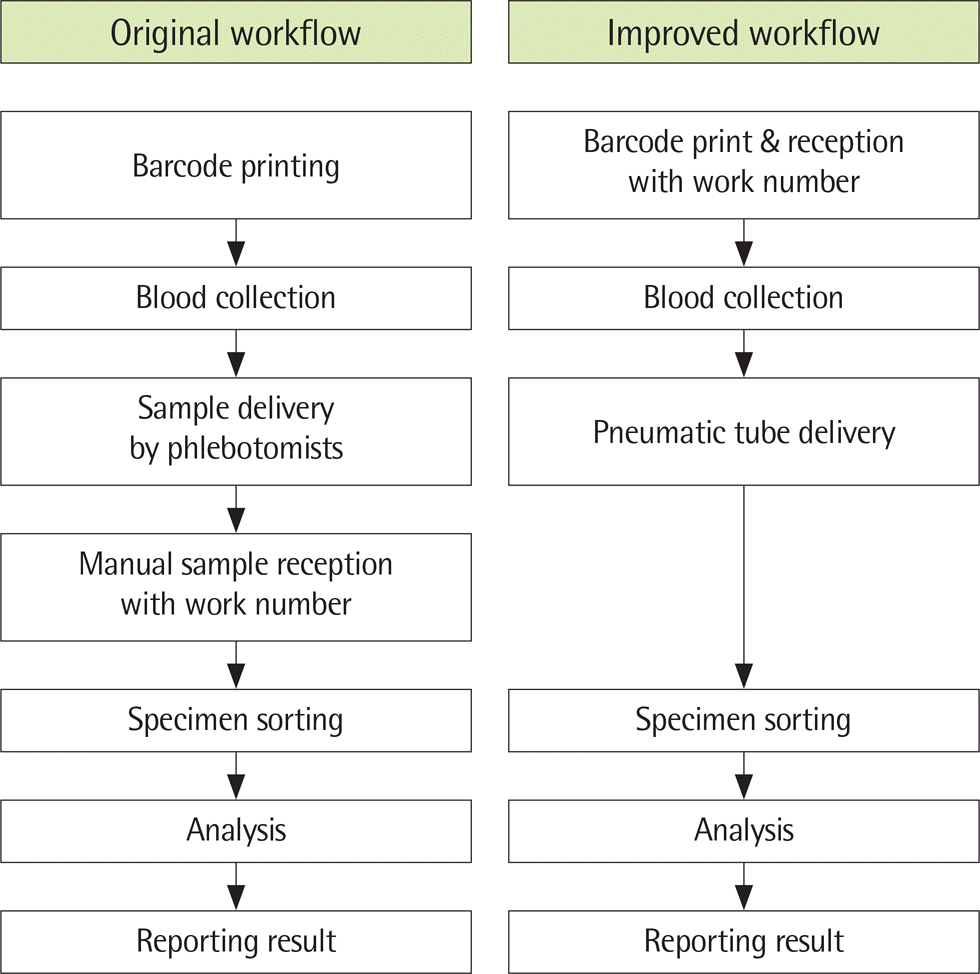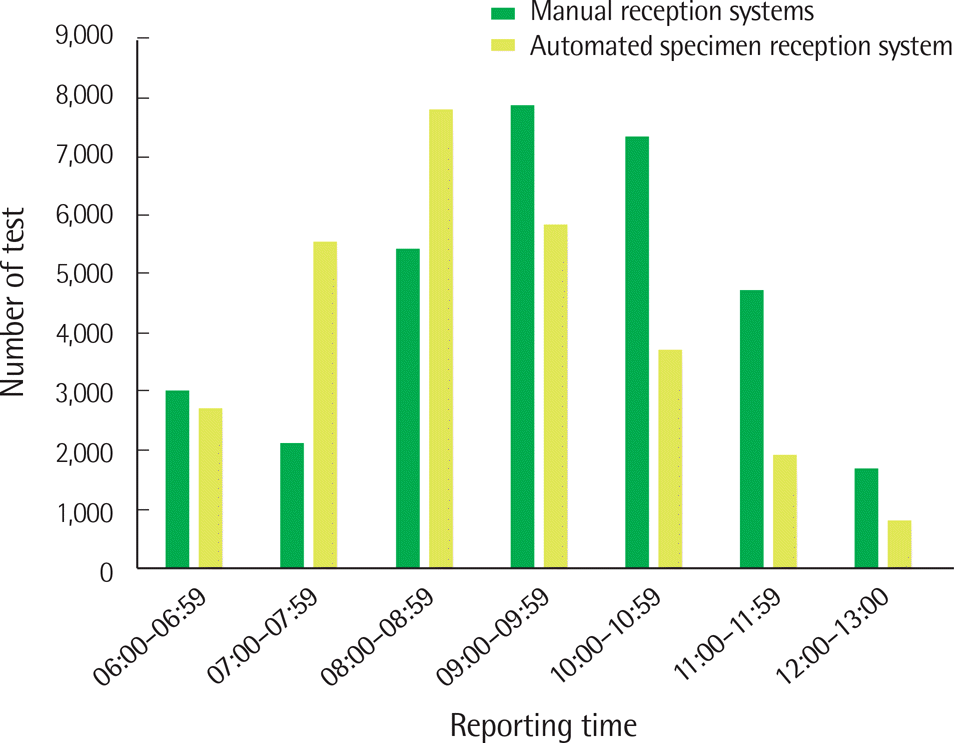Abstract
Background:
The returning time of inpatient specimen analysis is usually slow because phlebotomists deliver all the collected specimens at the end of their work cycle. In addition, manual specimen reception further delays the reporting time and imposes a heavy workload on the technical staff, thus compromising effectiveness. Therefore, we have created an automated specimen reception system to tackle testing delays and enhance the efficiency and quality of specimen collection and handling.
Methods:
In May 2015, the pre-analytical processing of inpatient samples was renovated. We automated the specimen reception in parallel with barcode printing and introduced pneumatic tubes to deliver samples for routine chemistry tests. We compared the reporting time of the automated system with that of the manual system and analyzed the distribution pattern of the specimens according to handling time.
Results:
The median reporting time was advanced by 41 minutes, from 09:33 AM to 08:52 AM for the manual and automated reception, respectively. Moreover, with the reduction in hands-on time, the blood specimens reached the laboratory immediately after phlebotomy, thereby improving the processing efficiency by spreading out the interval during which the specimens arrived in the laboratory. Additionally, the new system allowed the identification of the phlebotomist who collected the specimens and tracking the specimens from collection to test result.
REFERENCES
1.Breil B., Fritz F., Thiemann V., Dugas M. Mapping turnaround times (TAT) to a generic timeline: a systematic review of TAT defnitions in clinical domains. BMC Med Inform Decis Mak. 2011. 11:34.

2.Pati HP., Singh G. Turnaround time (TAT): difference in concept for laboratory and clinician. Indian J Hematol Blood Transfus. 2014. 30:81–4.

3.Steindel SJ., Jones BA., Howanitz PJ. Timeliness of automated routine laboratory tests: a College of American Pathologists Q-Probes study of 653 institutions. Clin Chim Acta. 1996. 251:25–40.

4.Jones BA., Bekeris LG., Nakhleh RE., Walsh MK., Valenstein PN. Physician satisfaction with clinical laboratory services: a College of American Pathologists Q-probes study of 138 institutions. Arch Pathol Lab Med. 2009. 133:38–43.

5.Novis DA., Dale JC. Morning rounds inpatient test availability: a College of American Pathologist Q-Probes study of 79,860 morning complete blood cell count and electrolyte test results in 367 institutions. Arch Pathol Lab Med. 2000. 124:499–503.
Fig. 1.
Improvement of the inpatient specimen processing workflow after the introduction of the automated specimen reception system.

Fig. 2.
Changes in the reporting time in terms of number of tests between the automated specimen reception system (from June 1, 2015 to June 30, 2015) and manual reception system (from March 1, 2015 to March 31, 2015).

Table 1.
Comparison of the average turnaround time between manual (from March 1, 2015 to March 31, 2015) and automated (from June 1, 2015 to June 30, 2015) specimen reception system for routine chemistry relative to reporting time
| Reporting time | Manual specimen reception | Automated specimen reception | ||
|---|---|---|---|---|
| No. of tests (%)∗ | TAT (min) | No. of tests (%)∗ | TAT (min) | |
| 05:00–05:59 | 3,544 (6.0) | 52.6 | 2,658 (5.2) | 50.6 |
| 06:00–06:59 | 2,984 (5.1) | 52.6 | 6,345 (12.5) | 50.3 |
| 07:00–07:59 | 4,807 (8.1) | 57.7 | 11,158 (22.0) | 64.5 |
| 08:00–08:59 | 14,155 (24.0) | 66.2 | 6,751 (13.3) | 72.4 |
| 09:00–09:59 | 8,969 (15.2) | 81.1 | 3,554 (7.0) | 62.2 |
| 10:00–10:59 | 3,461 (5.9) | 57.6 | 2,251 (4.4) | 47.2 |
| 11:00–11:59 | 2,098 (3.6) | 45.4 | 1,049 (2.1) | 41.7 |




 PDF
PDF ePub
ePub Citation
Citation Print
Print


 XML Download
XML Download